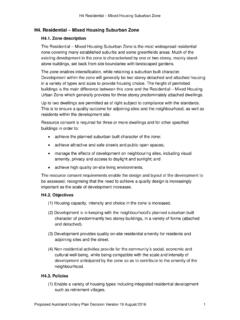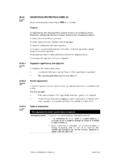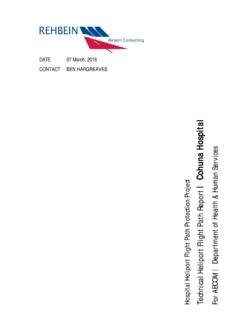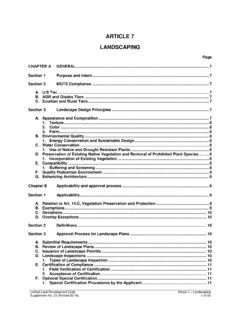Transcription of E26. Infrastructure [ENV-2016-AKL-000243: K …
1 E26 Infrastructure E26. Infrastructure introduction and other relevant regulatory requirements introduction Infrastructure is critical to the social, economic, and cultural well-being of people and communities and the quality of the environment. This section provides a framework for the development, operation, use, maintenance, repair, upgrading and removal of Infrastructure . As well as benefits Infrastructure can have a range of adverse effects on the environment, visual amenity of an area, and public health and safety. The sensitivity of adjacent activities, particularly residential, to these effects can lead to complaints and ultimately constraints on the operation of Infrastructure . Managing these reverse sensitivity effects is essential. Equally in some circumstances other activities and development need to be managed in a way that does not impede the operation of Infrastructure .
2 Infrastructure is provided for on the basis of Auckland-wide provisions. Additional Infrastructure provisions (zones, overlays and precincts), such as the National Grid Corridor Overlay, Auckland Airport Precinct and the Strategic Transport Corridor Zone are also provided throughout the plan and should be referred to where applicable. Designations may also provide for Infrastructure . The overlay and Auckland-wide provisions that are included in this section are set out in Table Table Structure Overlay or Auckland-wide provisions E26 sub-section reference Page number Network utilities and electricity generation All zones and roads Network utilities and electricity generation All zones and roads 3 D9 Significant Ecological Areas Overlay E15 Vegetation management and biodiversity Network utilities and electricity generation Vegetation management 30 D13 Notable Trees Overlay E16 Trees in open space zones E17 Trees in roads Network utilities and electricity generation Trees in roads and open space zones and the Notable Trees Overlay 40 E11 Land disturbance Regional E12 Land disturbance District Network utilities and electricity generation Earthworks
3 All zones and roads Network utilities and electricity generation Earthworks overlays except 49 62 [ENV-2016-AKL-000243: K Vernon] Addition sought Auckland Unitary Plan Operative in part 1 E26 Infrastructure Outstanding Natural Features Overlay Network utilities and electricity Generation Earthworks Outstanding Natural Features Overlay 76 D17 Historic Heritage Overlay Network utilities and electricity generation Historic Heritage Overlay 84 D18 Special Character Areas Overlay Residential and Business Network utilities and electricity generation Special Character Areas Overlay Residential and Business 90 D21 Sites and Places of Significance to Mana Whenua Overlay Network utilities and electricity generation Sites and Places of Significance to Mana Whenua Overlay 95 D14 Volcanic Viewshafts and Height Sensitive Areas Overlay Network utilities and electricity generation Volcanic Viewshafts and Height
4 Sensitive Areas Overlay 98 D15 Ridgeline Protection Overlay D16 Local Public Views Overlay D19 Auckland War Memorial Museum Viewshaft Overlay Network utilities and electricity generation Auckland War Memorial Museum Viewshaft, Local Public Views, Ridgelines Overlays 103 D10 Outstanding Natural Landscapes Overlay D11 Outstanding Natural Character and High Natural Character Overlay Network utilities and electricity generation Outstanding Natural Landscapes Overlay (excluding outstanding natural features) and Outstanding Natural Character and High Natural Character Overlay 109 D10 Outstanding Natural Features Overlay Network utilities and electricity generation Outstanding Natural Features Overlay (excluding outstanding natural landscapes) 114 other relevant regulatory requirements Where relevant , the requirements of the National Code of Practice for Utility (1)Operators Access to Transport Corridors will apply to the placement, maintenance, improvement and removal of utility structures in the road, unformed road and Strategic Transport Corridor.
5 The requirements of the Resource Management (National Environmental (2)Standards for Electricity Transmission Activities NESETA ) Regulations 2009 apply directly to the operation, maintenance, upgrading, relocation or removal of transmission line(s) that were operating or able to be operated on or prior to 14 January 2010 and remain part of the National Grid. In the case of conflict with any other provision of this plan, including any provision in the activity table in this section, the NESETA provisions shall prevail. Auckland Unitary Plan Operative in part 2 E26 Infrastructure The Resource Management (National Environmental Standards for (3)Telecommunication Facilities NESTF ) Regulations 2016 provide for: (a) the planning and operation of a telecommunication facility such as a mobile phone transmitter, that generates radio frequency fields as a permitted activity provided it complies with the New Zealand Standard on Radiofrequency Fields Part 1: Maximum Exposure Levels 3 kHz to 300 GHz (NZS : 1999); (b) the installation of telecommunication equipment cabinets in the road reserve as a permitted activity, subject to specified limitations on their size and location.
6 (c) noise from telecommunication equipment cabinets located in the road reserve as a permitted activity, subject to the specified noise limits; and (d) the installation or replacement of masts and antennas on existing structures in the road reserve as a permitted activity, subject to specified limitations on height and size. Compliance with the NZECP 34:2001 is mandatory under the Electricity Act (4)1992. All activities regulated by the NZECP 34:2001, including any activities that are otherwise permitted by the Plan must comply with this regulation. Connections to a network utility require approval of the relevant network utility (5)operator and works within roads require approval of the relevant road controlling authority. Network utilities and electricity generation All zones and roads Objectives [rp/dp] The benefits of Infrastructure are recognised.
7 (1) The value of investment in Infrastructure is recognised. (2) Safe, efficient and secure Infrastructure is enabled, to service the needs of (3)existing and authorised proposed subdivision, use and development. Development, operation, maintenance, repair, replacement, renewal, (4)upgrading and removal of Infrastructure is enabled. The resilience of Infrastructure is improved and continuity of service is (5)enabled. Infrastructure is appropriately protected from incompatible subdivision, use (6)and development, and reverse sensitivity effects. The national significance of the National Grid is recognised and provided for (7)and its effective development, operation, maintenance, repairs, upgrading and removal is enabled. The use and development of renewable electricity generation is enabled. (8) The adverse effects of Infrastructure are avoided, remedied or mitigated.
8 (9)Auckland Unitary Plan Operative in part 3 E26 Infrastructure Policies [rp/dp] Recognise the social, economic, cultural and environmental benefits that (1) Infrastructure provides, including: (a) enabling enhancement of the quality of life and standard of living for people and communities; (b) providing for public health and safety; (c) enabling the functioning of businesses; (d) enabling economic growth; (e) enabling growth and development; (f) protecting and enhancing the environment; (g) enabling the transportation of freight, goods, people; and (h) enabling interaction and communication. Provide for the development, operation, maintenance, repair, upgrade and (2)removal of Infrastructure throughout Auckland by recognising: (a) functional and operational needs; (b) location, route and design needs and constraints; (c) the complexity and interconnectedness of Infrastructure services; (d) the benefits of Infrastructure to communities with in Auckland and beyond; (e) the need to quickly restore disrupted services; and (f) its role in servicing existing, consented and planned development.
9 Adverse effects on Infrastructure Avoid where practicable, or otherwise remedy or mitigate adverse effects on (3) Infrastructure from subdivision, use and development, including reverse sensitivity effects, which may compromise the operation and capacity of existing, consented and planned Infrastructure . Adverse effects of Infrastructure Require the development, operation, maintenance, repair, upgrading and (4)removal of Infrastructure to avoid, remedy or mitigate adverse effects, including, on the: (a) health, well-being and safety of people and communities, including nuisance from noise, vibration, dust and odour emissions and light spill; (b) safe and efficient operation of other Infrastructure ; Auckland Unitary Plan Operative in part 4 E26 Infrastructure (c) amenity values of the streetscape and adjoining properties; (d) environment from temporary and ongoing discharges; and (e) values for which a site has been scheduled or incorporated in an overlay.
10 Consider the following matters when assessing the effects of Infrastructure : (5)(a) the degree to which the environment has already been modified; (b) the nature, duration, timing and frequency of the adverse effects; (c) the impact on the network and levels of service if the work is not undertaken; (d) the need for the Infrastructure in the context of the wider network; and (e) the benefits provided by the Infrastructure to the communities within Auckland and beyond. Consider the following matters where new Infrastructure or major upgrades to (6) Infrastructure are proposed within areas that have been scheduled in the Plan in relation to natural heritage, Mana Whenua, natural resources, coastal environment, historic heritage and special character: (a) the economic, cultural and social benefits derived from Infrastructure and the adverse effects of not providing the Infrastructure ; (b) whether the Infrastructure has a functional or operational need to be located in or traverse the proposed location; (c) the need for utility connections across or through such areas to enable an effective and efficient network.
![J1. Definitions [rps/rcp/rp/dp] - Auckland Council](/cache/preview/d/d/2/a/0/8/d/0/thumb-dd2a08d06e371f3ed80cf4e9fa2dd563.jpg)



![[CIV-2016-404-002333: Franco Belgiorno-Nettis] …](/cache/preview/5/c/8/9/4/8/0/b/thumb-5c89480b05b74af8de3dfd881b8f281a.jpg)












